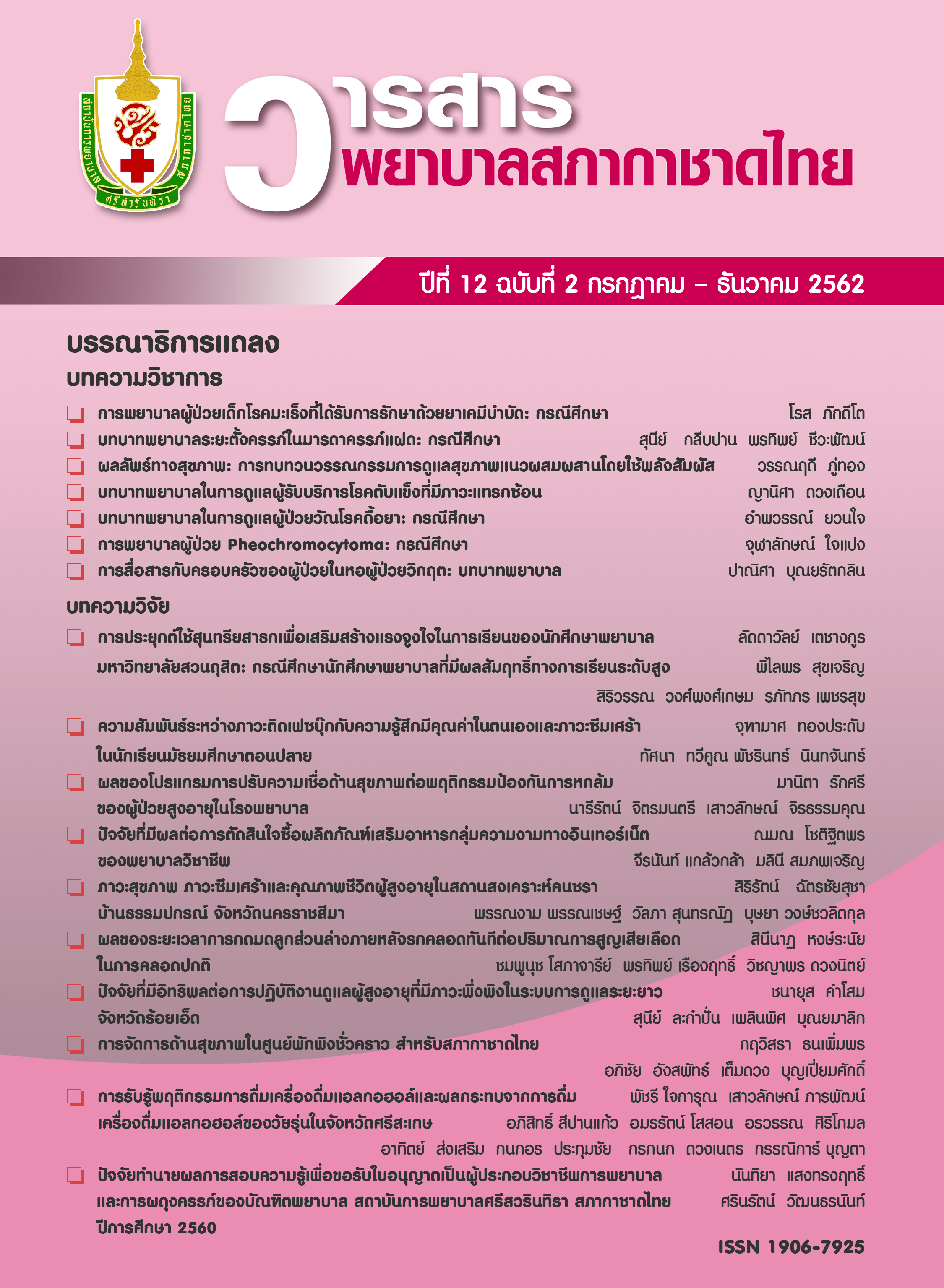Nursing Care for Pheochromocytoma: Case Study
Keywords:
pheochromocytoma, nursing care for pheochromocytoma, case studyAbstract
Pheochromocytoma, or a tumor of the adrenal medulla gland, is a disorders of the catecholamine hormone secretion which affecting multiple systems, especially in the cardiovascular system. Incidence of the disease is uncommon and can be cured by surgery with early detection. However, patients who have invasive or metastatic forms of malignant pheochromocytoma may affect the prognosis of the disease negatively. They risk danger of death. Therefore, patients need to be closely monitored and need complex nursing care to prevent complication. Nurses are the key for pheochromocytoma care because they work closely with the patient. The nurse must have an understanding of the pathology, signs, and symptoms of the disease, as well as treatment guidelines to provide nursing care correctly.
References
2. World Health Organization. ICD - O International Classification of Diseases for Oncology. 3 rd ed. Molta: WHO; 2013.
3. Pacak K. Eisenhofer G, Ahlman H, Bornstein SR, Gimenez-Roqueplo AP, Grossman AB, et al. Pheochromocytoma: recommendations for clinical practice from the first international symposium.
October 2005. Nat Clin Pract Endocrinol Metab 2007;3(2): 92-102.
4. Pederson LC, Lee JE. Pheochromocytoma. Curr Treat Options Oncol. 2003;4(4): 329-37.
5. Suzanne CO, Brenda GB, Janice LH, Kerry HC. Brunner and Suddarth’s textbook of medical-surgical nursing.12th ed. Philadelphia: Lippincott Williams & Wilkins; 2010.
6. Neumann HP, Bausch B, McWhinney SR, Bender BU, Gimm O, Franke G, et al. Germ-line mutations in nonsyndromic pheochromocytoma. N Engl J Med 2002;346(19):1459-66.
7. Juan D. Pheochromocytoma: clinical manifestations and diagnostic tests. Urology 1981;17(1):1-12.
8. Thippaporn T. Pheochromocytoma and Paraganglioma. In: Thippaporn T, editors. Adrenal gland disorder. Bangkok: Bangkok Wetchasan Printing House; 2012. p. 81-134. (in Thai)
9. Chearskul S, Kooptiwut S. The endocrine system. In: Watanapa W, Lohsiriwat S, Chearskul S, editors. Physiology I. 5 th ed. Bangkok: Department of Physiology Faculty of Medicine Siriraj Hospital; 2004. p. 255-303. (in Thai)
10. Siriviriyakul P. Adrenal glands. In: Watanatada P, Chansakul C, Eiam-Ong S. Basic physiology III. 4 th ed. Bangkok: Faculty of Medicine, Chulalongkorn University; 2005. p. 22-34. (in Thai)
11. Masahiko W. Headache in pheochromocytoma. In: Jose FM, Pheochromocytoma - a new view of the old problem. Shanghai: Intech China; 2011. p.103-10.
12. Lenders JW, Duh QY, Eisenhofer G, Gimenez-Roqurplo AP, Grebe SK, Murad MH, et al. Pheochromocytoma and Paraganglioma: an endocrine society clinical practice guideline. J Clin Endocrinol Metab 2014;99(6):1915–42.
13. Nuchpramool P, Poopipatpab S, Yuwapattanawong K. Update on Perioperative Management of Pheochromocytoma. Vajira Med J. 2015;59(4):35-47. (in Thai)
14. Chen H, Sippel RS, O'Dorisio MS, Vinik Al, Lloyd RV, Pacak K. et al. The North American Neuroendocrine Tumor Society consensus guideline for the diagnosis and management of neuroendocrine tumors: pheochromocytoma, paraganglioma, and medullary thyroid cancer. Pancreas. 2010;39(6):775–83.
15. Ayala-Ramirez M, Palmer JL, Hofmann MC, de la Cruz M, Moon BS, Waguespack SG, et al. Bone metastases and skeletal-related events in patients with malignant pheochromocytoma and sympathetic paraganglioma. J Clin Endocrinol Metab 2013; 98(4):1492-7.
16. Harry D. Treatment of malignant pheochromocytoma. West J Med 1978;128(2):106-11.
17. Wiang-chai P. Stress response. [Internet]. [updated 2014 May 14; cited 2019 Oct 7]. Available from: http://biology.ipst.ac.th/ความเครียด/ (in Thai)
18. Kinney MA, Narr BJ, Warner MA. Perioperative management of pheochromocytoma. J Cardiothorasc Vasc Anesth. 2002;16(3):359-69.
19. Karel P, Jacques WML, Graeme E. Pheochromocytoma: diagnosis, localization, and treatment. Oxford: Blackwell ; 2007.
20. Thai Hypertension Society. Thai guidelines on the treatment of hypertension 2012. [Internet]. [Updated 2015; cited 2019 Oct 7]. Available from: http://www.thaihypertension.org/files/GL%20HT% 202015.pdf. (in Thai)
21. Shah DS, Desai AR, Gohil N. A Comparision of effect of semi fowler’s vs side lying position on tidal volume & pulse oxymetry in ICU patients. IJMHS 2012;2(5):81–5.
22. Judy O, Lindsay S, Jagbir K. Symptom Management Guidelines: DYSPNEA. [Internet]. [Update 2013; cited 2019 Oct 9]. Available from: http: //www.bccancer.bc.ca/nursing-site/Documents/4.%20 Dyspnea.pdf.
23. Boonprasop S. Dyspnea: the role of a nurse. JHSR 2012;6(2):1-11. (in Thai)
24. Cancer Care Ontario’s. Symptom management guide-to-practice: dyspnea. [update: 2010; cited 2019 Oct 9]. Available from: http:// www.cehpcn.ca/uploads/CCO Dyspnea Symptom Management Guide to Practice 1284046306.pdf.
25. San Diego Patient Safety Taskforce. PCA guidelines of care December 2008 [Internet]. [update 2008; cited 2019 Oct 9]. Available from: http://www.hasdic.org/documents/tool-kit-pca.pdf.
26. Leaungsomnapa Y, Ngamkham S. Attention to pain. JPMC. 2013;30(1):83-93. (in Thai)
27. Ua-Kit N, Srikong P. Heart failure nursing care and advice. Journal of Public Health Nursing. 2013;27(1):131-43. (in Thai)
28. Bureau of Non Communicable Disease. Prevent the occurrence of non-communicable diseases in the lifestyle by reducing salt intake. Bangkok: Wvo Thai Printing; 2013. (in Thai)
Downloads
Published
Issue
Section
License
เนื้อหาบทความหรือข้อคิดเห็นต่างๆ ในวารสารพยาบาลสภากาชาดไทยนี้ เป็นความคิดเห็นของผู้เขียนบทความ ไม่ใช่ความเห็นของกองบรรณาธิการ หรือสถาบันการพยาบาลศรีสวรินทิรา สภากาชาดไทย






